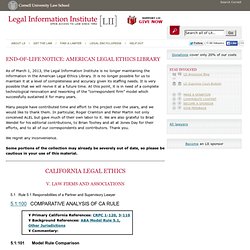

ABA Committee : State ethics rules on advertising may not apply to blogs and social networking. The ABA Standing Committee on the Delivery of Legal Services is proposing changes to the ABA Model Rules of Professional Conduct (pdf) to take into account, among other things, the status of law blogs and social networks.

Rule 7.1 (Attorney Advertising) and Comment 1 to the rule currently provide: A lawyer shall not make a false or misleading communication about the lawyer or the lawyer’s services. A communication is false or misleading if it contains a material misrepresentation of fact or law, or omits a fact necessary to make the statement considered as a whole not materially misleading.Comment [1] : This Rule governs all communications about a lawyer’s services, including advertising permitted by Rule 7.2.
Whatever means are used by a lawyer to communicate with a potential client about the lawyer or the lawyer’s services to make known a lawyer’s services, statements about them must be truthful. Law Library - Legal Ethics. Free LEGAL ETHICS AND TECHNOLOGY Document. View Full Essay LEGAL ETHICS AND TECHNOLOGY By William Freivogel www.freivogel.com Introduction This paper deals with how technology intersects with the legal ethics rules.
The relevant areas are competence, confidentiality, and conflicts of interest. Legalethics.com. The Cloud: Ethical Obligations for Lawyers in the Modern Era III. By Stacy O'Neil Jackson of IE Discovery Ethics in the Cloud As more organizations move their information to the cloud, attorneys must also understand the potential ethical issues involved in storing data off-site on the Internet, rather than on physical servers that the organization owns. There are several ethical issues to consider with the cloud: Records Management in the Cloud When organizations store information in the cloud, attorneys need to understand how the data can be retrieved. Lawyers also have an ethical duty to be familiar with retention policies for data in the cloud, so they know whether those policies are consistent with the organization's policies and whether the organization or the vendor is responsible for records management and destruction.
Protecting Data in the Cloud When data is stored in the cloud, jurisdictional issues become much more complicated. Recently, North Carolina issued a cloud computing ethics opinion. -- a review of the security policy; and. Legal Technology Institute - Independent Legal Technology Consulting Services. Andrew Z. Adkins III began consulting with the legal profession in 1989.
At that time, DOS 3.3 and WordPerfect 5.1 ruled the legal profession. There were relatively few local area networks in law firms, lawyers were still wondering if the fax machine was a breech of client confidence, and the Internet was only a gleam in Al Gore's eye. Adkins was one of the first legal technology consultants and one of only a handful of truly independent consultants, not selling or representing any vendor products. With his background and design experience as an electronics engineer, he has been able to provide his clients a unique perspective on using technology. Since those early pioneering days, there have been vast changes in technology and how the legal profession can take advantage of these technologies. Ethical issues in Electronic Information Systems. California Legal Ethics. As of March 1, 2013, the Legal Information Institute is no longer maintaining the information in the American Legal Ethics Library.

It is no longer possible for us to maintain it at a level of completeness and accuracy given its staffing needs. It is very possible that we will revive it at a future time. At this point, it is in need of a complete technological renovation and reworking of the "correspondent firm" model which successfully sustained it for many years. Many people have contributed time and effort to the project over the years, and we would like to thank them. In particular, Roger Cramton and Peter Martin not only conceived ALEL but gave much of their own labor to it. We regret any inconvenience. Some portions of the collection may already be severely out of date, so please be cautious in your use of this material. 5.1 Rule 5.1 Responsibilities of a Partner and Supervisory Lawyer 5.1:100 Comparative Analysis of CA Rule 5.1:101 Model Rule Comparison 5.1:102 Model Code Comparison.